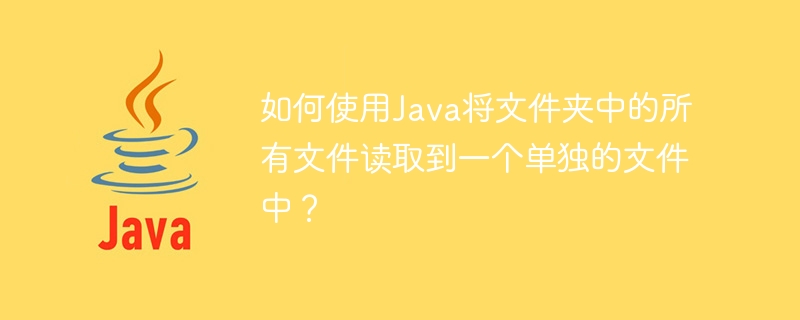Home >Java >javaTutorial >How to read all files in a folder into a single file using Java?
How to read all files in a folder into a single file using Java?
- 王林forward
- 2023-08-27 12:01:131416browse
The
listFiles() method of the
method of the
File class returns an array holding the current (file) object.
Read the contents of all files in a folder into a single file -
- By passing as argument the file path required to create the file object.
- Read the contents of each file using Scanner or any other reader.
- Append the read content to the StringBuffer.
- Write the StringBuffer contents to the desired output file.
Example
import java.io.DataOutputStream;
import java.io.File;
import java.io.FileOutputStream;
import java.io.IOException;
import java.util.Scanner;
public class Test {
public static void main(String args[]) throws IOException {
//Creating a File object for directory
File directoryPath = new File("D:\SampleDirectory");
//List of all files and directories
File filesList[] = directoryPath.listFiles();
System.out.println("List of files and directories in the specified directory:");
Scanner sc = null;
StringBuffer sb = new StringBuffer();
for(File file : filesList) {
System.out.println("File name: "+file.getName());
System.out.println("File path: "+file.getAbsolutePath());
System.out.println("Size :"+file.getTotalSpace());
//Instantiating the Scanner class
sc= new Scanner(file);
String input;
while (sc.hasNextLine()) {
input = sc.nextLine();
sb.append(input+" ");
}
System.out.println("Contents of the file: "+sb.toString());
System.out.println(" ");
//Instantiating the FileOutputStream class
FileOutputStream fileOut = new FileOutputStream("D:\output.txt");
//Instantiating the DataOutputStream class
DataOutputStream outputStream = new DataOutputStream(fileOut);
//Writing UTF data to the output stream
outputStream.write(sb.toString().getBytes());
outputStream.flush();
System.out.println("Data entered into the file");
}
}
}Output
List of files and directories in the specified directory: File name: sample1.txt File path: D:\SampleDirectory\sample1.txt Contents of the file: sample text file1 Data entered into the file File name: sample2.txt File path: D:\SampleDirectory\sample2.txt Contents of the file: sample text file2 Data entered into the file File name: sample3.txt File path: D:\SampleDirectory\sample3.txt Contents of the file: sample text file3 Data entered into the file
The above is the detailed content of How to read all files in a folder into a single file using Java?. For more information, please follow other related articles on the PHP Chinese website!
Statement:
This article is reproduced at:tutorialspoint.com. If there is any infringement, please contact admin@php.cn delete
Previous article:In Java, how to convert a list to an array?Next article:In Java, how to convert a list to an array?

